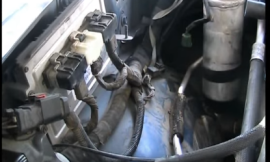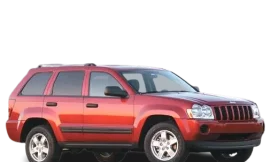Last updated on October 9th, 2023 at 05:35 pm
The Durango is a 1st Generation SUV by Dodge and as is the Dodge’s culture, as far as their engines are concerned; to install a new computer engine in each model every year. The computer receives data from the sensors and these sensors are unique to each and model of the Dodge Durango. Dodge vehicles prefer OEM sensors.
The vehicle’s engine can comfortable last an average of 250,000 miles with proper care and maintenance, driven at most 15,000 miles per year. The 1999 Dodge Durango model is a two-wheel drive, pretty versatile SUV with readily available spare parts and upgrades in the lights department. It comfortably seats 7 passengers and has great acceleration.
Just like any other electrical SUV, the Durango has its own share of Powertrain Control Module problems. The PCM being the brain of the vehicle, controls the engine, transmission and other electrical sensors. Some of the most common problems facing the 1999 Dodge Durango are:
Starting/Stalling Problems
If the Durango battery is shorted, the vehicle will develop problems when starting of stall all together while being driven. Batteries have a lifespan and they should be replaced when they start to fail and underperform. Normally, a diagnostic test might not produce any error codes, no “No Bus” showing on the odometer and the gauge might be fine too. Replacing the PCM might be the only solution to the problem
Bad alternator
If the serpentine belt gets damaged, the alternator ceases to power the electrics. Consequently, the headlights will dim, the radio will stop working and the battery will just die, showing a warning light because it’s not being charged. The PCM will develop problems because of the onboard electronics and computer controls. Current vehicles will have a “Check Engine” light on when an alternator is overcharging.
The alternator’s main job is to generate electricity to power the vehicle’s electrical components and to charge the battery. If a vehicle is turned on without an alternator, the engine won’t run because it wouldn’t have enough power. Durango’s are mighty sensitive to failing batteries. To test the voltage, switch off the engine then use a voltmeter by connecting it to the battery. Normal voltage reading is between 12 and 13 volts. If the reading is any lower that this, then it means there is a battery problem. The common causes for a bad alternator are:
- Computer error
- Damaged belt
- Wiring problems
- Blown fuse
- Faulty alternator or battery

Over heating
Overheating problems usually manifest when there is smoke from under the hood, the gasket head gets blown or a pegged temperature gauge. The issue of heating up might cause the engine to die whether the “No Bus” error code shows in the odometer or not. The thermostat and the radiator may be working fine but if the PCM and connectors heat up, the engine will shut down and will not start until the PCM cools down.
Transmission Problems
Transmission failures are easily noticeable. Most of the are often caused by inadequate transmission fluid levels, faulty transmission sensors, worn out gears and sparks, too much towing, dead torque converter and lack of general transmission service over time. The 1999 Durango’s have reported issues with their transmission. Basically, the shifting is not smooth and the “Check Engine” lights goes on most of the time. The error code on the scanner reads “P0720”. The transmission failures include grinding or even jumping when accelerating, delays in shifting, vehicle vibrating when on the road, a whistling sound coming from under the hood.
A burnt-out computer
A burnt-out computer is mainly caused by electronic failures like random current spikes or a voltage overcharge or undercharge. Weather conditions such as excess heat or humidity and poor workmanship will mess with the computer.
Other electrical problems like a bad wiring harness will lead to a burnt out PCM. There will be no communication between the PCM and the engine. If the connection sockets around it are damaged, or the plastic cable cover that protects the wires are broken, the wires will be exposed and they will deteriorate causing issues with the PCM. To keep off the electrical issues, the wiring harnesses have to be securely protected and grounded.
Bad/low Voltage
Low voltage is normally caused by one of 3 conditions: poor battery terminal, a low charged alternator or old age. Dodges do not perform well with worn out batteries. The lifespan of a battery should be a maximum of 4 years. If the battery load test is off, it should be replaced. When a car experiences low voltage, it means the alternator is failing to keep enough voltage out to give enough current to power the battery. Low charging output or alternator failure can be overlooked as a cause of poor ground connections. An undercharging will occur if the voltage falls to the positive side of the charging unit, and an overcharge will occur if the voltage falls to the negative side of the charging unit.
Conclusion
The Powertrain Control Module (PCM) is the vehicle’s central system. The vehicle’s
performance is based on data that the sensors relay to the PCM concerning the engine power
and transmission. You might decide to replace a faulty Dodge PCM by yourself, if you have the basic skills in motor engineering and some help from the internet. There is a detailed Youtube Video of the steps to take on the Flagship One Inc. channel. Dodge PCM are plug and play computers. PCM needs to be replaced whenever the vehicles experiences idleness, stalling or transmission failures. The workmanship over at this dealer re-manufactures all kinds of Dodge PCM with precision, due to their complexity. The PCM comes with a life time warranty. A SUV needs to have its PCM replaced after several years of driving due to the wear and tear.
FAQs
How do you reset the PCM on a 1999 Dodge Durango?
- Remove the ignition key
- In the hood of the Durango, locate the battery and using a wrench to loosen the lock nut, disconnect the negative terminal (black) from the battery then disconnect the positive cable. The PCM will lose its power.
- Wait for 5 minutes then reconnect the cables to their previous positions to reset the PCM.
- Turn the ignition key to “on” position, wait for a few seconds, then turn it to “off” position.
How do you test a Dodge PCM?
Step 1. Look up the generic trouble code on the On-Board Diagnostic (OBD-II) handbook to highlight the specific error code the PCM is showing, you could also get the Chrysler’s supplemental OBD-II from the internet
Step 2. Locate the Dodge’s computer outlet. Depending on the model, this connector could be just above the gas pedal or next to the left kick panel under the steering wheel.
Step 3. Connect the OBD-II scanner to the outlet, switch the scanner on, then turn on the Dodge’s electrical system. Note that different scanner brands have different functions.
Step 4. If the scanner does not display any codes, it could be that it is not programmed to automatically retrieve codes. The process of retrieving a code entails keying in a “Code Scan” command by pressing a button. Locate the specific code concerning the PCM issue by scrolling the display screen on the scanner.
What is a PCM on a 99 Dodge Durango?
The Powertrain Control Module (PCM) in a 99 Dodge Durango is the computerized circuit board that controls the engine, transmission and other electrical systems in the SUV, based on the data it receives from its sensors. The PCM is found on the right of the engine compartment (the passenger side), just outside the engine firewall.
Where is the PCM located on a 1999 Dodge Durango?
The PCM on a Dodge Durango is found on the right of the engine compartment (the passenger side), just outside the engine firewall.




